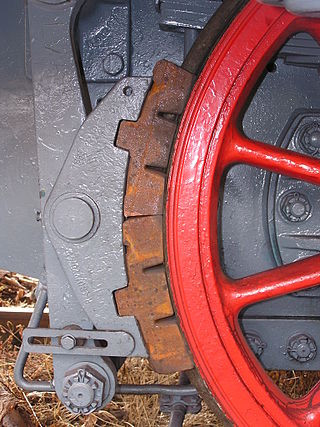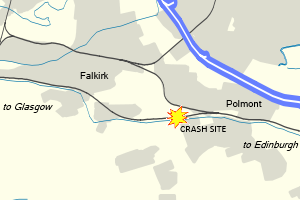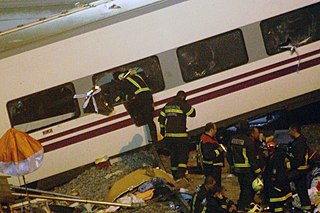Related Research Articles

The town of Morpeth in Northumberland, England, has what is reputed to be the tightest curve of any main railway line in Britain. The track turns approximately 98° from a northwesterly to an easterly direction immediately west of Morpeth Station on an otherwise fast section of the East Coast Main Line railway. This was a major factor in three serious derailments between 1969 and 1994. The curve has a permanent speed restriction of 50 miles per hour (80 km/h).

A railway brake is a type of brake used on the cars of railway trains to enable deceleration, control acceleration (downhill) or to keep them immobile when parked. While the basic principle is similar to that on road vehicle usage, operational features are more complex because of the need to control multiple linked carriages and to be effective on vehicles left without a prime mover. Clasp brakes are one type of brakes historically used on trains.

The Polmont rail accident, also known as the Polmont rail disaster, occurred on 30 July 1984 to the west of Polmont, near Falkirk, in Scotland. A westbound push–pull express train travelling from Edinburgh to Glasgow struck a cow which had gained access to the track through a damaged fence from a field near Polmont railway station, causing all six carriages and the locomotive of the train to derail. 13 people were killed and 61 others were injured, 17 of them seriously. The accident led to a debate about the safety of push–pull trains on British Rail.

The Thirsk rail crash occurred on 31 July 1967 at Thirsk, Yorkshire, England on the British Rail East Coast Main Line.
The railways of New South Wales, Australia have had many incidents and accidents since their formation in 1831. There are close to 1000 names associated with rail-related deaths in NSW on the walls of the Australian Railway Monument in Werris Creek. Those killed were all employees of various NSW railways. The details below include deaths of employees and the general public.

The Grantham rail accident occurred on 19 September 1906. An evening Sleeping-Car and Mail train of the Great Northern Railway, running from London Kings Cross to Edinburgh Waverley hauled by Ivatt 'Atlantic' No 276 derailed, killing 14. The accident was never explained; the train ran through Grantham station, where it was scheduled to stop, and derailed on a set of points on a sharp curve at the end of the platform, which at the time had been set for a freight train. No reason was ever established as to why the train did not stop as scheduled, or obey the Caution and Danger signals.
The Rednal rail crash was a rail accident that occurred near Rednal station in Shropshire.
The Torre del Bierzo rail disaster occurred on 3 January 1944 near the village of Torre del Bierzo in the El Bierzo region of Spain's León province when three trains collided and caught fire inside a tunnel. Although the official death toll was 78, and at the time it was estimated to be 200–250, the most recent study has estimated it at no more than 100.
The Pretoria train accident occurred on 21 April 2010 when a train of carriages ran away for 12 miles (19 km) from Centurion Station and derailed at Pretoria. Three people were killed and seven were seriously injured.
The Slough rail accident happened on 16 June 1900 at Slough railway station on the Great Western Main Line when an express train from London Paddington to Falmouth Docks ran through two sets of signals at danger, and collided with a local train heading for Windsor & Eton Central. Five passengers were killed; 35 were seriously injured, and 90 complained of shock or minor injuries

The Saint-Michel-de-Maurienne derailment of December 12, 1917 was a railway accident involving a troop train carrying at least 1,000 French soldiers on their way home for leave from the Italian front in World War I. A derailment as the train descended the Maurienne valley on the Culoz–Modane railway caused a catastrophic crash and subsequent fire in which more than 675 died. It is still France's deadliest rail accident to date.

The Brandsen rail disaster occurred on March 8, 1981, in Brandsen, a town in Buenos Aires Province in Argentina, when a passenger train carrying 803 passengers collided head-on with a freight train, killing 34 and injuring another 74. The train crash was caused by points failure.

The Santiago de Compostela derailment occurred on 24 July 2013, when an Alvia high-speed train traveling from Madrid to Ferrol, in the north-west of Spain, derailed at high speed on a bend about 4 kilometres (2.5 mi) outside of the railway station at Santiago de Compostela. Of the 178 people injured, the provisional number of deaths in hospital had reached 79 by the following 28 July.

The 1990 Back Bay, Massachusetts train collision was a collision between an Amtrak passenger train, the Night Owl, and a Massachusetts Bay Transportation Authority (MBTA) Stoughton Line commuter train just outside Back Bay station in Boston, Massachusetts, United States. An investigation by the National Transportation Safety Board (NTSB) found that the Amtrak train entered a speed-restricted curve at excessive speed, causing the train to derail and crash into the MBTA commuter train on an adjacent track. Although no one was killed in the accident, 453 people were injured and Back Bay station was closed for six days. Total damage was estimated at $14 million. The accident led to new speed restrictions and safety improvements in the vicinity of Back Bay and a revamp of Amtrak's locomotive engineer training program.

The technical investigation of the Lac-Mégantic rail disaster looked into the instigating and mitigating factors regarding the incident, one of the deadliest in Canadian railway history, with 47 deaths. It identified 18 factors related to the cargo, maintenance of the tracks, maintenance and operation of the train, and weak government oversight all combined to produce the disaster. Five recommendations for change resulted from the investigation.
References
- ↑ "Accidente de Queronque". Archived from the original on January 26, 2010. Retrieved August 2, 2010.
- ↑ The Times. March 13, 1971. page 4 column C.
{{cite news}}: Missing or empty|title=(help)[ full citation needed ] - ↑ "Boy, 6, Blamed In Rail Tragedy". Lubbock Avalanche-Journal. Lubbock, TX. March 14, 1971. p. 32 – via Newspapers.com.

- ↑ "Child Blamed for Chilean Rail Mishap". Daily Press. Newport News, VA. March 14, 1971. p. 14 – via Newspapers.com.

- "Historia del FFCC de La Serena a Rivadavia". AmigosDelTren.cl (in Spanish). Archived from the original on July 7, 2011.